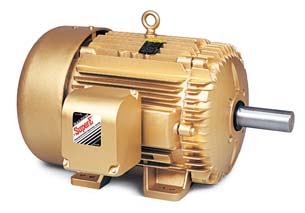New Efficiency Mandates for Motors
Latest News
March 1, 2011
By DE Editors
 Image courtesy of Baldor Electric Co. |
Design engineers who specify motors need to be aware of mandated energy efficiency standards that the federal Energy Independence and Security Act (EISA) put into effect in December 2010. The information below is courtesy of Baldor Electric Co., a manufacturer of electric motors, mechanical power transmission products, drives and generators.
Q. What is EISA?
A. The Energy Independence and Security Act of 2007 (EISA) was passed by Congress and signed into law on Dec. 19, 2007. EISA builds upon the previous EPAct (Energy Policy Act of 1992) updating mandated efficiency standards for general purpose, three-phase AC industrial motors from 1 to 500 horsepower (HP) which are manufactured for sale in the United States. The U.S. Department of Energy (DOE) is responsible for establishing the rules to implement and enforce EISA.
Q. When is the effective date for EISA?
A. EISA applies to motors manufactured after Dec. 19, 2010. The Canadian version was scheduled to begin Jan. 1, 2011, but has not been signed yet.
Q. What are the efficiency standards under EISA?
A. For each general-purpose rating (Subtype I) from 1 to 200 HP that was previously covered by the EPAct, the law specifies a nominal full-load efficiency level based on NEMA Premium efficiency. All 230 or 460 volt (and 575 volts for Canada) motors currently under the EPAct, manufactured after Dec. 19, 2010, must meet or exceed this efficiency level. General Purpose Electric Motors (Subtype II) not previously covered by the EPAct will be required to comply with Energy Efficient efficiencies (NEMA MG1, table 12-11). The term ‘general purpose electric motor (Subtype II)’ means motors incorporating the design elements of a general purpose electric motor (subtype I) that are configured as one of the following:
• U-Frame motor
• Design C motor
• Close-coupled pump motor
• Footless motor
• Vertical solid shaft normal thrust motor (as tested in a horizontal configuration)
• An 8-pole motor (900 rpm)
• A poly-phase motor with voltage of not more than 600 volts (other than 230 or 460 volts
• Fire pump motors 1-200 HP
• 201 – 500 HP motors not previously covered by the EPAct will be required to comply with Energy Efficient efficiencies as defined by NEMA MG 1, table 12-11.
Q. Are fractional HP and 48 or 56 frame motors included in EISA?
A. Only 1 to 500 HP motors with three-digit frame NEMA numbers (143T-up) are included in EISA. This also includes equivalent IEC frame designations (IEC 90 frame-up excluding 100 frame).
Q. What motors aren’t covered by EISA?
A. The following motors are not covered:
• Design D with high slip
• Adjustable speed with optimized windings
• Customized OEM mounting
• Intermittent duty
• Integral with gearing or brake where motor cannot be used separately
• Submersible motors
• Single Phase motors
• DC motors
• Two-digit frames (48-56)
• Multi-speed motors
• Medium voltage motors
• TENV and TEAO enclosures
Q. Does EISA apply to every three-phase electric motor from 1 to 500 HP?
A. Not every configuration, but almost all motors except some special OEM designs with proprietary mounting configurations. The following configurations are exempt from EISA:
• Integral gearmotors
• Integral brake motors
• Inverter duty motors with windings optimized for ASD use that cannot be line-started
• Design D high-slip motors
Q. Does EISA apply to both stock and custom motors?
A. Yes. The determining factor under EISA is whether a particular motor meets the law’s definition of “electric motor.” Stock and custom motors should be treated the same and follow EISA guidelines.
Q. Does EISA apply to motors manufactured outside of the United States and imported for use?
A. Yes. The requirements of EISA include imported electric motors. This also includes the electric motors “as a component of another piece of equipment”.
Q. How about electric motors for export outside of the United States?
A. EISA does not apply to motors exported outside the United States, including motors mounted on equipment. The DOE will require these motors or their boxes to be specifically marked “Intended for Export.”
Subscribe to our FREE magazine, FREE email newsletters or both!
Latest News
About the Author
DE’s editors contribute news and new product announcements to Digital Engineering.
Press releases may be sent to them via [email protected].






